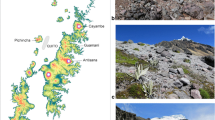Abstract
One of the most endangered assemblages of species in Europe is insectsassociated with old trees. For that reason there is a need of developing methodsto survey this fauna. This study aims at comparing three methods – windowtrapping, pitfall trapping and wood mould sampling – to assess speciesrichness and composition of the saproxylic beetle fauna in living, hollow oaks.We have used these methods at the same site, and to a large extent in the sametrees. Useful information was obtained from all methods, but they partiallytarget different assemblages of species. Window trapping collected the highestnumber of species. Pitfall trapping collected beetles associated with treehollows which rarely are collected by window traps and therefore it isprofitable to combine these two methods. As wood mould sampling is the cheapestmethod to use, indicator species should preferably be chosen among specieswhich are efficiently collected with this method.
Similar content being viewed by others
References
Antonsson K. and Wadstein M. 1991. Eklandskapet. En naturinventering av hagar och lovskögar i eklandskapet S. om Linköping. Länsstyrelsen i Östergötlands län, Linköping (in Swedish).
Baars M.A. 1979. Catches in pitfall traps in relation to mean densities of carabid beetles. Oecologia 41: 25–46.
Biström O. and Väisänen R. 1988. Ancient-forest invertebrates of the Pyhän-Häkki national park in Central Finland. Acta Zoologica Fennica 185: 1–69.
Dajoz R. 1980. Écologie des insectes forestièrs. Gauthier-Villars, Paris.
Gärdenfors U. (ed.) 2000. The 2000 Red List of Swedish Species. ArtDatabanken, Uppsala, Sweden.
Greenslade P.J.M. 1964. Pitfall trapping as a method for studying populations of Carabidae (Coleoptera). Journal of Animal Ecology 33: 301–310.
Hammond H.E.J. 1997. Arthropod biodiversity from Populus coarse woody material in north-central Alberta: a review of taxa and collection methods. Canadian Entomologist 129: 1009–1033.
Harding P.T. and Rose F. 1986. Pasture-Woodlands in Lowland Britain. A Review of Their Importance for Wildlife Conservation. Institute of Terrestrial Ecology, Huntingdon, UK.
Jansson N. and Lundberg S. 2000. —Skalbaggar i ihåliga ädellövträd – två nya arter för Sverige jämte återfynd av kortvingarna Hypnogyra glabra (Nordmann) och Meliceria tragardhi (Palm) [Beetles in hollow broadleaved deciduous tree – two species new to Sweden and the staphylinid beetles (Coleoptera: Staphylinidae) Hypnogyra glabra and Meliceria tragardhi found again in Sweden] (in Swedish, English summary). Entomologisk Tidskrift 121: 93–97.
Jonsell M. and Nordlander G. 1995. Field attraction of Coleoptera to odours of the wood-decaying polypores Fomitopsis pinicola and Fomes fomentarius. Annales Zoologici Fennici 32: 391–402.
Kaila L. 1993. A new method for collecting quantitative samples of insects associated with decaying wood or wood fungi. Entomologica Fennica 4: 21–23.
Koponen S., RinneV. and Clayhills T. 1997. Arthropods on oaks branches in SW Finland, collected by a new trap type. Entomologica Fennica 8: 177–183.
Krebs C.J. 1989. Ecological Methodology. Harper & Row Publishers, New York.
Lundberg S. 1995. Catalogus Coleopterorum Sueciae. Naturhistoriska Riksmuseet, Stockholm, Sweden.
Martikainen P. 2002. Conservation of threatened saproxylic beetles: significance of retained aspen Populus tremula on clearcut areas. Ecological Bulletins 49: 205–218.
Martikainen P., Siitonen J., Punttila P., Kaila L. and Rauh J. 2000. Species richness of Coleoptera in mature managed and old-growth forests in southern Finland. Biological Conservation 94: 199–209.
Niemelä J., Halme E. and Haila Y. 1990. Balancing sampling effort in pitfall trapping of carabid beetles. Entomologica Fennica 1: 233–238.
Nilsson S.G. and Baranowski R. 1997. Habitat predictability and the occurrence of wood beetles in old-growth beech forests. Ecography 20: 491–498.
Nilsson S.G., Hedin J. and Niklasson M. 2001. Biodiversity and its assessment in boreal and nemoral forests. Scandinavian Journal of Forest Research Supplement 3: 10–26.
Økland B. 1996. A comparison of three methods of trapping saproxylic beetles. European Journal of Entomology 93: p95–209.
Palm T. 1959. DeDie Holz-und Rindenkäfer der Süd-und Mittelschwedischen Läubbaume [The wood and bark coleoptera of deciduous trees in southern and central Sweden] (in German, English summary). Opuscula Entomologica Supplementum XVI: 1–374.
Ranius T. 2000. Minimum viable metapopulation size of a beetle, Osmoderma eremita, living in tree hollows. Animal Conservation 3: 37–43.
Ranius T. 2001. Constancy and asynchrony of populations of a beetle, Osmoderma eremita living in tree hollows. Oecologia 126: 208–215.
Ranius T. 2002. Influence of stand size and quality of tree hollows on saproxylic beetles in Sweden. Biological Conservation 103: 85–91.
Ranius T. and Jansson N. 2000. The influence of forest regrowth, original canopy cover and tree size on saproxylic beetles associated with old oaks. Biological Conservation 95: 85–94.
Ranius T. and Nilsson S.G. 1997. Habitat of Osmoderma eremita Scop. (Coleoptera: Scarabaeidae), a beetle living in hollow trees. Journal of Insect Conservation 1: 193–204.
Ranius T., Antonsson K., Jansson N. and Johannesson J. 2001. Inventering och skötsel av gamla ekar i Eklandskapet söder om Linköping [Inventories and management of old oaks in an area south of Linköping, Sweden] (in Swedish, English summary). Fauna och Flora 96: 97–107.
Rundlöf U. and Nilsson S.G. 1995. Fem Ess metoden. Naturskyddsföreningen, Stockholm (in Swedish).
Siitonen J. and Saaristo L. 2000. Habitat requirements and conservation of Pytho kolwensis, a beetle species of old-growth boreal forest. Biological Conservation 94: 211–220.
Speight M.C.D. 1989. Saproxylic Invertebrates and Their Conservation. Council of Europe, Strasbourg, France.
Spence J.R. and Niemelä J.K. 1994. Sampling carabid assemblages with pitfall traps: the madness and the method. Canadian Entomologist 126: 881–894.
Author information
Authors and Affiliations
Rights and permissions
About this article
Cite this article
Ranius, T., Jansson, N. A comparison of three methods to survey saproxylic beetles in hollow oaks. Biodiversity and Conservation 11, 1759–1771 (2002). https://doi.org/10.1023/A:1020343030085
Issue Date:
DOI: https://doi.org/10.1023/A:1020343030085




